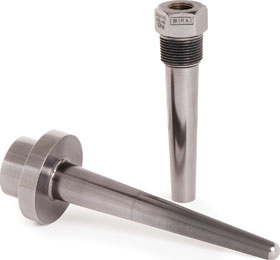

For temperature measurements in highly corrosive industrial processes, the use of thermometer thermowells in special materials is a necessity. In the design of the measuring point, tantalum should also be considered as a thermowell material, in addition to the well-known special materials such as hastelloy, monel and titanium. Tantalum, which is often more expensive to purchase initially, can prove itself to be the more economical option over many years of use when looked at from the viewpoint of the TCO. This because plant shutdowns and associated production downtime due to maintenance or damage to the measuring point can be avoided.
Design choices affect total cost of ownership
In general, thermometer thermowells are not made entirely of tantalum, but designed as a flange version (eg, per DIN 43772 form 2F or 3F) in 1,4571 stainless steel and the wetted parts are protected against the process medium by a tantalum cover. The advantages of this design are an insertion length into the process that can be set to almost any length and a general acceptance of such a design by the market. A disadvantage, however, is the limitation to flanges as a process connection, a restricted design of the thermowell shape and a deterioration of the response time of the measuring point in comparison with a thermowell without a tantalum cover.
If all the design options need to be exploited in order to design the thermowell, say, with a measuring point to customer drawings with threads and still tantalum should be used as the special material, there is no alternative to coating with tantalum.
WIKA, in close cooperation with tantaline, has developed a method of applying tantalum to stainless steel thermowells via a chemical vapour deposition process, in a layer of 50-200 m thick. This tantalum layer is different from conventional methods, such as sputtering or electroplating, in that, in the tantaline process, a metallurgical bond (surface alloying) to the stainless steel base body is generated. This surface alloying ensures a perfect bonding between the stainless steel and the tantalum, even if the thermowell is exposed to rapid temperature swings.
Advantages of the tantaline process
The simplified description of the tantaline process is that, in a reactor vessel under vacuum, vaporised tantalum is deposited onto the stainless steel thermowell, where it forms a surface alloy which builds up over time to the desired layer thickness. The corrosion resistance of every thermowell is checked in a final quality check for 48 hours at 100°C in 36% hydrochloric acid.
As mentioned at the start, the cost of a thermowell with tantalum cover in relation to a thermowell made of special material, with respect to the TCO, cannot be given directly. The costs for the tantalum cover are affected by the surface to be coated on the thermo-well (amount of tantalum required) and the batch size in relation to the dimension of the thermowell. Due to these technical factors, there is a cost advantage over thermowells in special materials when there are relatively small elements in larger batches, especially when there is a version of the thermowell in stainless steel for less critical measuring applications held on stock.
Due to the increasing demands on plant safety, the strength calculation for thermometer thermowells is becoming increasingly important. The most significant calculation, ASME PTC 19.3-2010, however, excludes calculation for fabricated thermowells or solid-machined types with coatings or rough surfaces. Since the tantalum coating, with a thickness of 50 m, neither affects the surface roughness nor the vibration characteristics, WIKA can advise on the ASME PTC 19.3-2010 calculation as an engineering service.
In summary, thermometer thermowells coated using the tantaline process can have clear advantages over a conventional tantalum cover or a thermowell from special materials, without diminishing the right of established thermowell designs with removable tantalum covers to exist.
| Tel: | +27 11 621 0000 |
| Email: | [email protected] |
| www: | www.wika.co.za |
| Articles: | More information and articles about WIKA Instruments |

© Technews Publishing (Pty) Ltd | All Rights Reserved